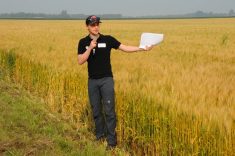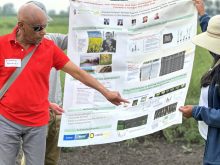This year marks 50 years since Baldur Stefansson of the University of Manitoba registered Tower, the first canola variety that had oil low in erucic acid and meal low in glucosinolates.
Stefansson couldn’t have predicted in 1974 the juggernaut the western Canadian canola industry would become.
Other stories in the Canola Yearbook 2024:
- Shrinking production estimate supports canola bids
- Canola goals must be reassessed to match market reality
- Canola growing season in review
- Canola remains a Prairie economic powerhouse
- Bill C-234 ping pongs between Senate and House
- Canola News Briefs
- Verticillium, blackleg and gophers
- Sustainability incentive for canola growers
- What made canola so strong?
- Science news briefs
- Tiny allies may help withstand drought
- Canola and climate change in Western Canada
- Production news briefs
- The future of gene editing in canola
- Canola views – photo essay
This year, 21.8 million acres were planted to canola. The crop supports more than 60,000 jobs across Canada. In 2022-23, it generated an estimated $22.54 billion in direct economic activity, as you will read in a story in this 2024 Canola Yearbook.
Read Also

Geopolitics can change trade routes
WHISTLER, B.C. — Today’s geopolitical tensions could have dire long-term consequences, says the director of international policy at the University…
The varieties, production methods and related industry have changed radically since Stefansson’s time, but one thing that’s remained constant is that Mother Nature bats last.
Early in the 2024 growing season, there was ample moisture available in many growing regions, so plants didn’t have to send their roots deep into the soil profile for moisture.
Then when the rain stopped and the blistering July and August heat arrived, crops in multiple areas didn’t have the root structure to compensate.
In some areas, there just wasn’t enough moisture in the soil profile during midsummer regardless of root structure.
Curtis Wightman from Neilburg, Sask., posted a few photos on X that I think exemplified this well. The first image taken from the seat of his sprayer is of a beautiful looking crop and another image taken from the seat of his combine shows the same crop that wasn’t so pretty.
He said this was the best start and the worst finish he’s ever had growing canola.
I hosted a panel discussion at the Ag In Motion farm show in July on canola genetics where Robert Misko, who farms east of Roblin, Man., said it would be helpful if breeders developed a set of “water wings” to help the crop pull through high moisture conditions early in the year.
Canola crops in his area were stunted this summer because the region received too much rain early in the growing season.
On this important anniversary of the first canola variety to be commercialized, another important milestone has occurred that will soon help farmers get their hands on canola varieties that hit more checkmarks on their crop characteristics wish list.
A pathway for gene edited crops has been established in Canada.
Last year, Agriculture Canada announced the updated guidance for Part V of the Seeds Regulations. The environmental pre-market assessment guidance treats gene edited crops essentially the same as plants bred conventionally.
This year, the Canadian Food Inspection Agency provided guidance on livestock feed, which cleared the final regulatory hurdle for the commercialization of crops developed with the help of gene editing.
Curtis Rempel, vice-president of crop production and innovation at the Canola Council of Canada, said gene editing as a tool is already well developed and well defined.
He said gene editing will quickly enable yield improvements and increase stress tolerance of canola.
“They’re (researchers) taking some of the starch-branching enzymes that are present in corn and over-expressing them in canola. They already exist in canola so that the gene families are conserved,” Rempel said.
This will enable canola to have better high temperature tolerance. It’s only one of a host of characteristics scientists are using gene editing to achieve.
“The big one would be insect resistance because there’s not a lot of genes in nature in any plants that give you a lot of insect resistance,” Rempel said.
Through the process of domestication, natural variability and protection within crops can be lost, and tools such as gene editing and RNA interference can help bring some of that protection back.
“We want low glucosinolates in canola, but if you never had it in the seed, but you had high glucosinolates in the root and in the leaves, would it repel flea beetles? It might, we don’t know, but it seems like some of the plants in nature that have higher levels of glucosinolates have less flea beetle feeding,” Rempel said.
I imagine the idea of bringing glucosinolates back into canola varieties would have made Stefansson raise an eyebrow.
Rempel said the ability to use gene editing combined with new imagery technology and artificial intelligence will soon cause variety development to change dramatically and rapidly.
“It’s going to be a step changer because a lot of working with genes is working with data. It will help us understand gene expression over different environments,” Rempel said.
Crop scientists are a few years away from fine tuning and combining these new, extremely powerful technologies.
However, all signs suggest the industry is on the cusp of a new era in crop genetics.
Contact robin.booker@producer.com
















